Written by: Rosemary Hallberg, Communication Specialist, Southern IPM Center
Even though nearly all media attention is on mosquitoes this summer, most people fear ticks more. At A Bug Day in Gastonia in May, I talked to several people who weren’t as worried about mosquitoes as they were about ticks. Perhaps that’s because ticks attach to a person and hang on for a while.
If a tick bites you or someone in your family, you’re probably going to go to the doctor’s office. And what is the doctor going to ask? Probably what kind of tick bit you! Each tick transmits a different pathogen, so it’s important to know which species of tick bit you. That will help the doctor determine what to treat you for.
However, that’s sometimes easier said than done! Ticks are very small, and most times they look alike. If they’re engorged, they look very different from the pictures of flat ticks. You could also be spending a lot of time trying to identify the tick, and your health care provider may not have any better luck identifying it.
There are about 20 different tick species in the US; however, many of them do not attack humans. Many of them, such as the American dog tick, have a wide geographic range. Others, like the western blacklegged tick, live in a very specific area.
If you knew what ticks you might be dealing with, wouldn’t that speed up your chances for identification? For instance, if you live in Virginia, what are your chances of being bitten by a Gulf Coast tick? If you live in Florida, do you have to worry about Rocky Mountain Spotted Fever?
The CDC has several maps that give a general idea of the range of the seven most common ticks. To make things even clearer, I’m going to list the tick species by state, along with the diseases that they transmit, at least for the southern United States. The links on the states will bring you to a page with more information from that state about the ticks and the diseases they transmit.
The list below contains the most common ticks in each state, not every single tick species in the state. Be sure to take a sample of the tick that you find when you go to the doctor.
For large pictures of many of these ticks, go to identify.us.com . That web site also has more detailed information about the life stages of each tick species as well.
American dog tick
Credit: TAMU Tickapp
American dog tick: Most common in the Piedmont area. Transmits Rocky Mountain spotted fever but NOT Lyme disease.
Brown dog tick, photo credit University of Florida
Brown dog tick: Rarely attacks people but is common on dogs. They like to climb up draperies and walls. They’re found throughout the country, so you’ll encounter them wherever you go. Transmits Rocky Mountain spotted fever.
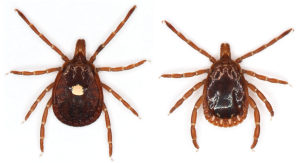 Lone star tick, male and female
Lone star tick, male and female
Credit: Oklahoma State University
Lone Star tick: These attack people, deer and dogs. Adults and nymphs are around in the spring and summer; the larvae are out in the fall. It can be found mostly in the coastal plain but is also found in the piedmont. The larvae, called seed ticks, prefer humans. These ticks cause Southern Tick Associated Rash Infection, or STARI. The Lone Star tick also causes erhlichiosis.
blacklegged tick, female, male and previous life stages
Credit: Centers for Disease Control
Blacklegged tick: Adults attack dogs and deer. Also known as the deer tick. Adults are active in late fall, spring and early winter. Transmits Lyme disease, anaplasmosis, babesiosis and Powassan disease.
Same species as in North Carolina.
Lone Star tick: This is the most common tick species in Georgia, according to entomologists.
American dog tick: Feeds on humans only in the adult stage. For more on this and the blacklegged tick, see the web page on ticks at Georgia.edu.
Blacklegged tick
Same species as in North and South Carolina.
Gulf coast tick
Tickinfo.com
Gulf Coast tick: This tick is also present in the Southeast closer to the coast but is more widely prevalent in Alabama. Adult ticks feed on deer. This tick transmits Rickettsia parkeri rickettsiosis, a form of spotted fever.
Brown dog tick, American dog tick, Lone Star tick, Gulf coast tick and blacklegged tick
Blacklegged tick: In Louisiana, this tick feeds on reptiles, so it does not transmit Lyme disease.
Gulf Coast tick: Larvae and nymphs feed on birds and small rodents, while adults feed on deer and other wildlife.
Lone star tick
American dog tick
Brown dog tick
The Mississippi tick publication has detailed descriptions of the common diseases transmitted by ticks. It contains descriptions of symptoms as well as the ticks that these diseases are associated with.
Blacklegged tick: They will appear as adults in fall, winter and early spring.
Lone star tick: Appear as adults in early spring and summer, nymphs in spring and late summer and larvae in fall.
Gulf Coast tick: Appear as adults in late spring and summer.
American dog tick: Appear as adults in late spring, summer and fall.
Brown dog tick: Appear in summer but bite dogs but not people.
In addition to the tick species in the rest of the South, watch for (all images from TAMU tick app):
Cayenne tick
Cayenne tick: This tick is cold-sensitive but can sometimes be found in southern Florida. They have very long mouthparts, so a bite can be painful and can cause tissue damage. Transmit Rocky Mountain Spotted Fever and rickettsia south of the US border.
Tropical horse tick: Found only in the southernmost edges of Texas and Florida. Primary host is equine but they also feed on deer and other farm animals. Transmits equine proplasmosis to horses.
Cattle tick: Found in a few counties along the Rio Grande Valley and in Mexico. Its primary host is cattle, to which it can transmit Texas cattle fever. It does not usually attack humans. It is a regulated species.
Southern cattle tick: Found only in the southernmost tip of Texas and in northern Mexico. Primary host is cattle, but it will also feed on other mammals. It is a regulated species.
Winter tick: Commonly called the “moose tick” because moose are its primary host. However, it will also feed on domestic animals and people if given the opportunity. It is a one host tick, completing its entire life cycle on a single host. Causes anaplasmosis in cattle.
Spinose ear tick: A soft tick, this species is distributed throughout the US. Farm and wild animals are its primary hosts, but it will also feed on people. It is found in the ear canals of its host, hence the name. There are no known pathogens associated with this tick.
The link above goes to a publication with detailed descriptions of each tick species and about the diseases that are common from ticks in Oklahoma.
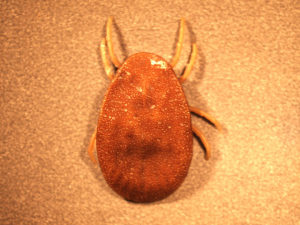 Class Aracnida, Order Acarina, fowl tick dorsal side Class Aracnida, Order Acarina, fowl tick dorsal side, AgriLife Extension
Class Aracnida, Order Acarina, fowl tick dorsal side Class Aracnida, Order Acarina, fowl tick dorsal side, AgriLife Extension
Fowl tick: Feeds on chickens. Feeds primarily during the day, and can live for years without feeding. This is a soft tick.
Spinose ear tick: More common in cattle, horses and other animals in Oklahoma, but sometimes feeds on humans.
Blacklegged tick: Does not transmit Lyme disease in Oklahoma because it doesn’t feed on mice.
Winter tick: An important pest of cattle, deer, horses and elk in Oklahoma. It is the only one-host tick in the state. It becomes very large when engorged, so it’s easily seen on animals.
American dog tick: Are a serious pest in wooded areas. It is the only known vector of Rocky Mountain Spotted fever in Oklahoma. It also transmits bovine anaplasmosis and ehrlichiosis.
Lone star tick: This tick is the most commonly encountered tick recreationally in the state. It transmits several diseases, including ehrlichiosis, STARI, Heartland virus and Rickettsia.
Gulf coast tick: has become more of a problem in Oklahoma in the past several years. Its primary host is cattle and can cause tick paralysis in cattle and humans.
American dog tick: One of the primary tick species in Kentucky, not a vector of Lyme disease.
Lone star tick: can transmit Rocky Mountain Spotted fever.
NOTE: despite the fact that the two most common tick species in Kentucky do not transmit Lyme disease, there have been cases of Lyme disease in the state.
American dog tick: This and the Lone star tick are the two most common ticks in the state.
Lone star tick: This and the American dog tick are the two most common ticks in the state.
Brown dog tick: Usually found in places where dogs live in spring and summer months.
American dog tick: Transmits Rocky Mountain Spotted Fever and Tularemia on the east coast.
Lone star tick: This is the most common tick in the state.
Blacklegged tick: Primary host is white-tailed deer.
Brown dog tick
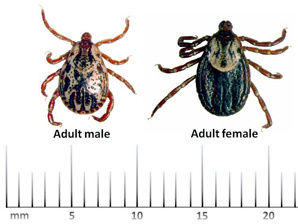
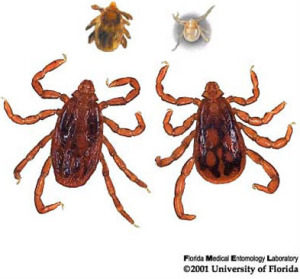
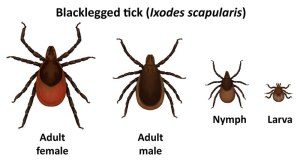

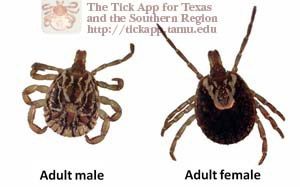
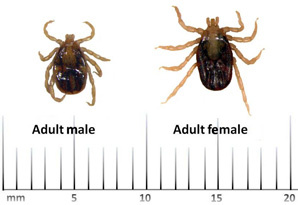
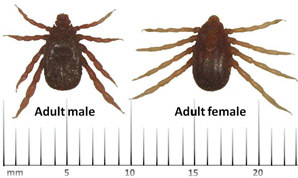
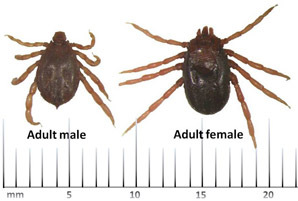
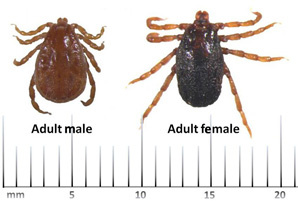
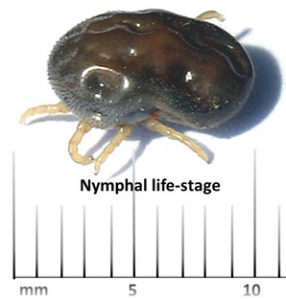

 .
.